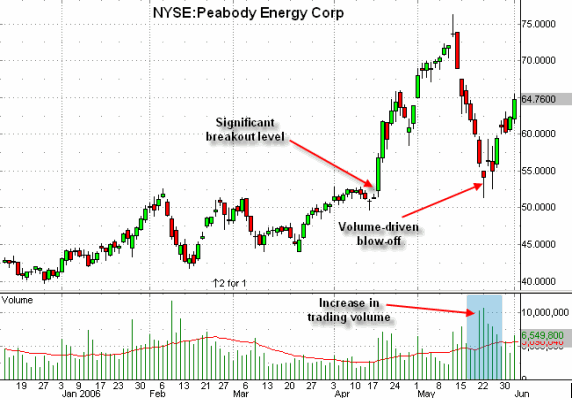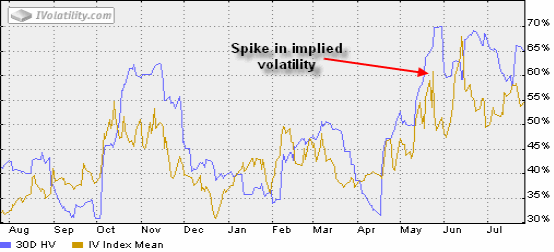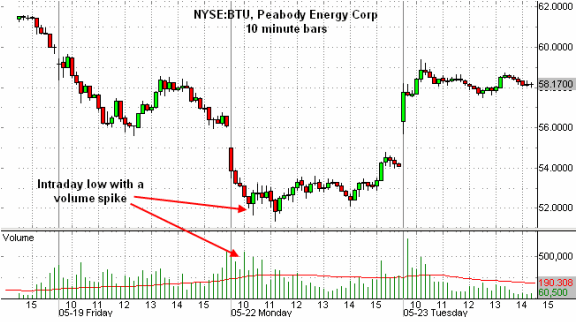A rare options setup worth waiting for
In my experience as a trader and fund manager, I have found
options to be a truly amazing set of financial instruments. The flexibility of
options and the numerous ways where they can be applied provide excellent
opportunities for traders employing various strategies: portfolio insurance,
income generation, arbitrage or just outright speculation. These styles all have
their merits and are exceedingly profitable when applied in proper market
context. Today I’d like to focus on the style most often used by the average
trader and the one that happens to be my personal favorite: speculation.
I must warn you, though, that while pure speculation is a very lucrative trading
style, it is not the staple in the overall activities of our fund. We use it
judiciously when just the right sort of opportunity arises in the overall market
context. Regardless of the relative infrequency of its application the profits
generated by this trading style contribute greatly to the bottom line. The very
reason they do is that we are extremely selective when it comes to making
speculative bets and when we do make a bet a significant portion of our capital
gets committed to it.
The strategy that is described below isn’t difficult to execute but its biggest
caveat is the trader’s ability to stick with it. That is why it is fundamental
for the opportunity to be just right — only then will the trader have the
necessary level of confidence to stay in the trade long enough to capitalize on
the expected outcome of the strategy.
The idea behind the strategy is fairly simple and it was born out of a more
complex income generation approach that I use with great consistency. As the
story goes, for some time our fund has been shorting call and put options with
the intent of collecting premium. We’ve perfected our option selling methods to
the point where obtaining a pre-determined monthly return has become highly
probable. The problem was that while it was nice to be generating consistent
returns, we had a very tightly capped upside. We needed a strategy that would
give us that occasional high multiple on an investment and add some positive
non-linearity to our equity curve.
Basically, we wanted a consistent, repeatable way to make a quick, blatant hit
and walk away with a bag of money.
So, it was back to the drawing board time. As we started digging through our
past trades an interesting fact emerged: some of our short premium collapsed
quicker then we had been projecting due to a simultaneous implosion in implied
volatility and a directional move of the underlying stock. Nothing really new
here except that after defining the actual context surrounding these occurrences
it became clear that we would have done a lot better if we augmented our short
selling strategy with buying long premium against our short options. An
observant reader here will ask, “but doesn’t the long premium get completely
obliterated due to the very vol implosion you had observed?†Good question and
here is an answer: of course it does, but it’s a matter of timing of that
implosion versus the directional move in the stock that precedes it.
We’ll discuss this strategy in detail shortly. Before we do, let’s define some
criteria. First of all, we must understand risk. There are two types that we’ll
need to worry about: directional risk and volatility risk. There is also a small
issue of time decay, but since this strategy stays in a trade for only a few
days (sometimes slightly over a week), this particular risk is minor. Consider
it “rent†for owning the option.
Directional risk has everything to do with the stock and nothing with the option
itself so we can define it in terms of the underlying price. In contrast, the
volatility risk is all about the option and we’ll need a way to either hedge it
or limit the duration of the position in order to mitigate the exposure of the
premium to (an almost inevitable) implosion in vol.
Having highlighted the risk involved, let’s now focus on the risk/reward
equation. How much do we want to make? When researching this strategy the answer
we came up with was “at least double the moneyâ€. The reason for this was that
the mere infrequency of trading using this approach dictates that the
opportunity would allow for a high-multiple return. In other words, when all the
stars align and we actually get filled the way we want (all of which happens
relatively rarely), we stand to make a lot of money. It is important to realize
is that since we are expecting at least a 100% return, the risk can be
commensurate and as such, gives us plenty of leeway to stay in the trade.
In short, we can bet $100 for “double or nothingâ€. That itself is sufficient to
make money as long as we’re right more than half the time. However, the really
good news is that we don’t have to lose all of $100 when we’re wrong. In
practice, we’ll risk $100 in order to either lose $50-$60 or make $100. Do the
math to find the expectation of returns even if the strategy is “wrong†half the
time, and you’ll have a nebulous vision of a money minting press.
Now, let’s move on to the actual trading approach. The approach has two parts: a
strategic identification of the trading opportunity, and a tactical entry. Both
parts must be fulfilled in order to the overall strategy to work well (and, most
importantly, to enable you to stay in the trade).
Strategically, the following criteria will capture the opportunity:
- The stock of choice must have a steady short-term downtrend
consisting of a series of non-stop, down-down-down price action. - The downtrend must be followed by a down trading day
accompanied by extremely high trading volume (at least double of 20-30 day
moving average) - The price of the stock during this last trading day must
get to (or preferably exceed) an important level established sometime in the
past. This can be a support level or a prior breakout point. - The price should have traded through a near round number
(5’s are considered round) - The implied volatility of the ATM option must have spiked
to a new level or at least has approached a previous high.
Now, it is obvious from the above that if the stock price
meets the above criteria, there is going to be a severely oversold situation. In
order to make this situation “betterâ€, or more oversold, a tactical approach for
the entry follows the following two rules:
- The stock must make an intraday low during the first 1.5
hours of trading or the last hour before the close. - The low must be accompanied by an intraday spike in volume
(again, above some average)
These entry rules can be applied on the same day when the
strategic criteria have been met (the position would be taken on during the
second half of the day) or the following day (a trader would look for en entry
in the morning).
Now, the expected result would be a strong bounce in the stock resulting in at
least a 10% move. Translated into options terms, the result is at least a 100%
return or more, depending on the levels of implied volatility and the chosen
strike price.
Let’s look at a concrete example. On 5/22 we bought BTU Jun 60 Calls for $1.40.
We then sold half of them the following day for $3.10 and the rest a few days
later for $3.00. Below are two charts depicting the trade:

On 4/18/06 BTU broke out of a range on high volume and proceeded to rally. After
reaching the top, a vicious downtrend followed, characterized by the sort of
down-down-down action we would look for. On 5/19/06 it traded in the vicinity of
the 4/18 level on double the normal volume. In addition, the implied volatility
skyrocketed to 61% – far above its average. Our strategic criteria were nearly
fulfilled. We then needed to stock to trade through a whole number (55) and get
down to 52.50, which was the root of the 4/18/06 breakout.

The following day opened down and the rest of our strategic criteria were
fulfilled simultaneously with tactical ones:

After trading right through 55, by 10 a.m. the stock traded near the key 52.50
level set on 4/18/06 and bottomed on high intraday volume. That was the perfect
time to enter the trade.
The implied vol was still high (61%) and we chose the 60 strikes as the option
with the highest probability to double. We could have chosen the 55 strikes, but
we’d have to commit more capital and while we’d make more in the end, we
wouldn’t double our money. And we like to double! On a serious note, 55’s would
be fine as well, but being right at the money they carried more vol risk than
the 60’s.
Now, with this strategy, exiting the trade is much simpler than entering. In
essence, double your money and get out. In our case we sold half the position
the next day (the morning’s rally on high volume gave us a tactical exit along
with the options having already doubled). We kept the other half to “test†the
strategy and see whether it was likely to get a 200% return. That was indeed
possible but after two additional holding days we decided to sell out the rest
of the position at the same price. The ensuing action did take the stock to 65
within the next four days and would have actually quadrupled the return.
Lucrative as it may sound, we would never wait that long (and don’t recommend
that you do) for two reasons:
- The vol implosion took place within 2-3 days after the
initiating trade. Had you waited longer and the stock hadn’t rallied any
higher, you’d give up a lot of your options premium. That’s vol risk for you. - The probability of the stock rallying higher after the
initial bounce gets highly diluted. So, keep the options if you wish, but
realize that at that point you’re gambling.
An observant reader would now ask the question: “why not just
trade the stock? After all, you’re using options just for leverage, right?
Good question. And, no, we don’t use options for leverage. Here are the reasons
for options being the instrument of choice for this strategy:
- When we purchase options, our risk is only the premium. So,
if we invest $20K into a position, that’s all we can lose. - More importantly, when we buy options we own gamma, which
means that the position loses money slower when the stock goes against us.
Inversely, the position makes money faster when it goes in our favor. - Additionally, we own vega, which means that when the stock
decides to go lower the implied volatility is likely to rise, which offsets
some of our directional losses. - Finally, our dollar outlay is just the cost of the option.
With the stock we’d have to maintain a margin requirement, which would cost a
lot more.
Let’s go through a quick exercise: Let’s assume that in the
above scenario I bought 100 June 60 calls at $1.40. They cost me $14,000. Let’s
also assume that a trader next to me decided to capitalize on the opportunity by
buying an equivalent measure of stock.
Since the option’s delta at the time was about 26, he would have to buy 2600
shares (100 calls * 26 delta) in stock to simulate my position. This would cost
him $137,800 ($53 * 2600 shares) and entail a margin requirement of $68,900.
Now, let’s look at the risk: imagine that the stock plummets three points from
the level where I bought the options ($53). With the stock at $50, our calls
would be worth $0.65 resulting in a loss of $7,500. At the same time, the
equivalent position in stock would lose $7,800. Not much difference? Take the
stock down another two points and we have losses of $10,000 and $13,000
respectively. At that moment our stock trader is a lot unhappier than I am.
On the profit side, a 5-point move up puts the options at $3.10 and a
corresponding profit of $17,000 as compared to a $13,000 profit generated by an
equivalent position in stock. Again, my smile is bigger than the stock trader’s
smirk.
So, the options made more money and, adding insult to injury, the stock trader
didn’t double his money. Now, that’s a real bummer!
So, what’s the take away from this trading approach? Can you make money using
it? Honestly, I don’t know, as it really depends on your patience, ability to
handle risk and the stomach to take losses. You also have to really want to win,
but that’s a topic for an entirely different article.
If you have learned anything today, it’s this: Take the time to find a rare,
unique, concrete opportunity that makes the world of sense to you and trade it
to make serious money. Do it just a couple of times a month and eventually
you’ll realize that the less you trade, the better you’ll do in the long run.
And the long run is what matters.
Dmitry Babayev is a portfolio manager and derivatives strategist at
Cadence Capital Group, LLC, a Manhattan
based money management firm. His main focus at the firm is on premium selling,
aggressive long/short and delta-neutral strategies. He also maintains a blog,
Live Options Trading (with
corresponding coverage of stocks, ETFs and futures) reflecting the actual
activities of Cadence Capital Group.
